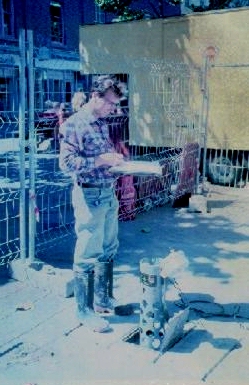
The two neutron probe access tubes were successfully installed into hand-augered boreholes on 14 and 15 June 1995. The depth of installation of each monitoring point is shown in Table 18. Allowing for the design of the neutron probe, the effective length of both access tubes from which the probe can record soil moisture measurements is 3.80m.
Table 18: Access tube installation
| Borehole number | Monitoring point installed | Ground level, upper surface of pavement slab (m AOD) | Length of access tube installed (m) | Length of access tube installed (m) | Base of access tube (m AOD) |
|---|---|---|---|---|---|
| 1 | Access tube | 13.50 | 3.97 | 13.40 | 9.43 |
| 3 | Access tube | 13.34 | 3.95 | 13.22 | 9.27 |
Material recovered during creation of each borehole was described in detail, and the index of the findings are reported here in Table 20. The method of borehole creation, using a hand auger, limited the availability of sample material for laboratory processing. However, because the deposits into which the access tubes were installed appeared to be similar to those described during installation of the dipwell, reference is made to the results of borehole 2 sample analysis, reported in Tables 29 and 30.
On 27 June, the neutron probe was connected to each access tube to record three count rates at 100mm intervals. A mean of these values was calculated and then a count rate ratio determined by dividing the mean with the water standard mean (R/Rs). The 'Rs' value is a mean count rate when the probe is at 100 per cent moisture level. This value is determined before use of the probe in the field, by attaching it to an access tube installed within a water-filled chamber. A 'soil' specific calibration line obtained for the neutron probe system is then applied to the R/Rs ratio to obtain a moisture volume fraction.
Figure 7: The operation of the neutron probe on Access Tube 1

Though it was not possible to produce a site-specific calibration line, the archaeological deposits had many of the characteristics of a peaty organic soil. Therefore using a calibration line determined for clay/peat soils, the following calculation was possible:
Moisture Volume Fraction = 0.958 � R/Rs - 0.012 (Bell 1976)
The neutron probe data collected on 27 June 1995 and calculated moisture volume fractions are presented in Tables 35 and 36. It should, however, be noted that the use of a standard calibration line rather than a site-specific line necessitates that the reported moisture volume fractions be regarded as estimated and not absolute values.
The techniques available to produce a site-specific calibration line include a drum, field and theoretical calibration. Unfortunately, the drum calibration conducted in the laboratory and the field calibration techniques would both have required substantial quantities of the archaeological deposit, which it was not possible to obtain without causing unnecessary disturbance to the site. The theoretical calibration technique relies on the detailed chemical analysis and bulk density determination of the deposit, and on a number of mathematical approximations. Again, it was not possible to obtain sufficient undisturbed material to perform bulk density calculations, and mathematical approximations applicable to the archaeological deposits are not as yet available.
© Author(s). Content published prior to 2013 is not covered by CC-BY licence and requests for reproduction should usually go to the copyright holder (in most cases, the author(s)). For citation / fair-dealing purposes, please attribute the author(s), the title of the work, the Internet Archaeology journal and the relevant URL/DOI.
Last updated: Thur Feb 28 2002